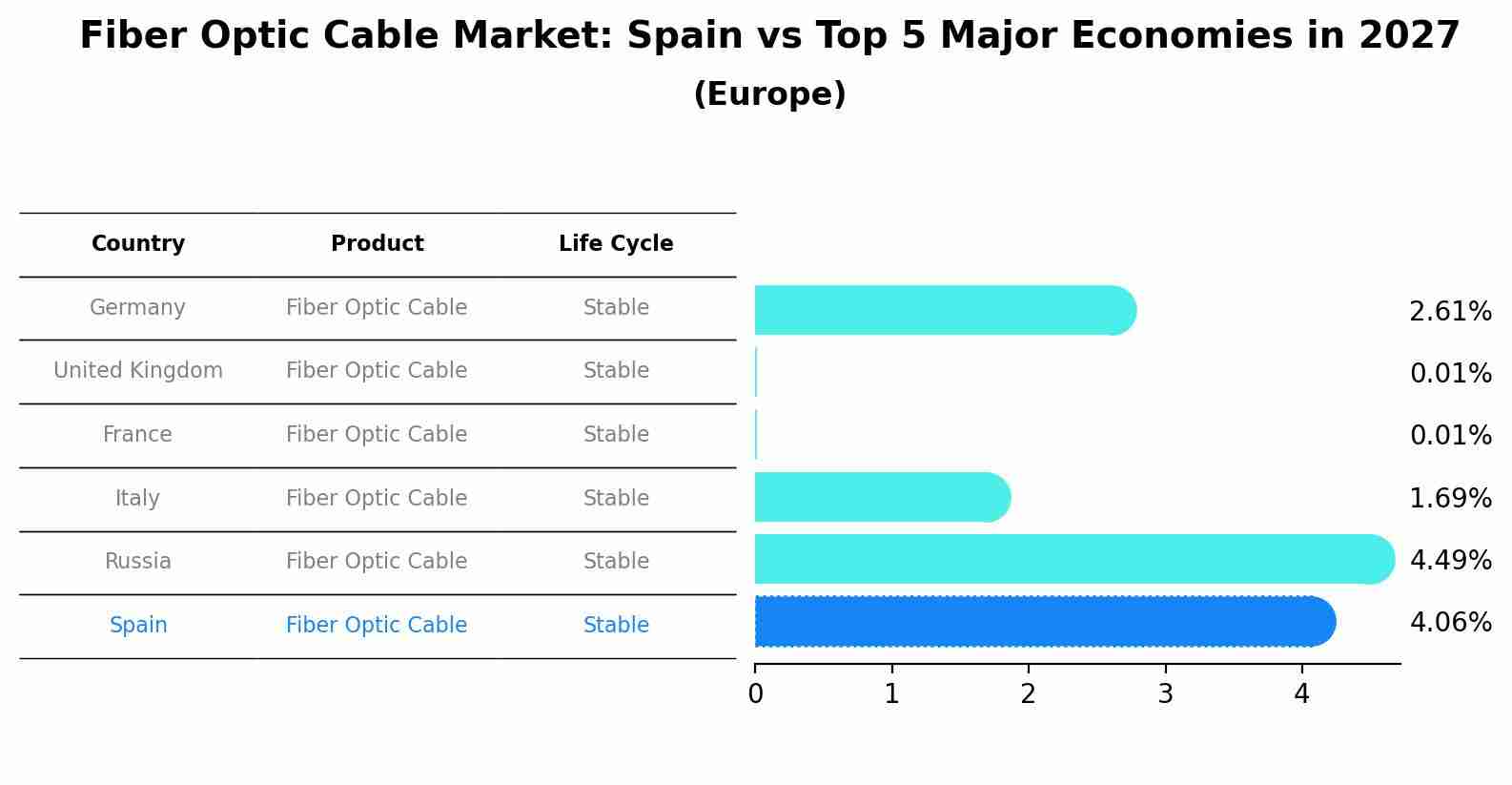Spain Fiber Optic Cable Market Outlook | Share, Companies, Forecast, Industry, Size, Trends, COVID-19 IMPACT, Value, Analysis, Revenue & Growth
| Product Code: ETC363974 | Publication Date: Aug 2022 | Updated Date: Jul 2025 | Product Type: Market Research Report | |
| Publisher: 6Wresearch | Author: Sumit Sagar | No. of Pages: 75 | No. of Figures: 35 | No. of Tables: 20 |
Spain Fiber Optic Cable Market Size Growth Rate
The Spain Fiber Optic Cable Market is projected to witness mixed growth rate patterns during 2025 to 2029. The growth rate starts at 4.30% in 2025 and reaches 8.50% by 2029.

Fiber Optic Cable Market: Spain vs Top 5 Major Economies in 2027 (Europe)
By 2027, the Fiber Optic Cable market in Spain is anticipated to reach a growth rate of 4.06%, as part of an increasingly competitive Europe region, where Germany remains at the forefront, supported by United Kingdom, France, Italy and Russia, driving innovations and market adoption across sectors.

Spain Fiber Optic Cable Market Synopsis
The Spain Fiber Optic Cable Market is experiencing significant growth due to the increasing demand for high-speed internet and advanced telecommunications infrastructure in the country. The market is driven by factors such as the proliferation of data centers, rising adoption of cloud services, and government initiatives to expand broadband connectivity. Key players in the market are investing in research and development to introduce innovative fiber optic cable solutions that offer higher bandwidth and faster data transmission speeds. The market is also witnessing a trend towards the deployment of fiber optic networks in urban areas to support smart city initiatives and improve overall connectivity. Overall, the Spain Fiber Optic Cable Market is poised for continued expansion as businesses and consumers increasingly rely on high-performance internet connectivity for various applications.
Spain Fiber Optic Cable Market Trends
The Spain Fiber Optic Cable Market is experiencing significant growth driven by the increasing demand for high-speed internet connectivity, the rise in data center deployments, and the adoption of advanced technologies such as 5G and Internet of Things (IoT). The market is witnessing a shift towards higher bandwidth fiber optic cables to support the growing data traffic and the need for faster and more reliable network connections. Additionally, the government initiatives to expand broadband infrastructure and the investments by telecom operators in upgrading their networks are further fueling the market growth. With the ongoing digital transformation across various industries and the increasing consumer reliance on digital services, the demand for fiber optic cables in Spain is expected to continue rising in the coming years.
Spain Fiber Optic Cable Market Challenges
In the Spain Fiber Optic Cable Market, one of the main challenges faced is the high initial investment required for infrastructure development. Deploying fiber optic cables involves significant costs for laying down the cables, installation of networking equipment, and maintenance. Another challenge is the existing legacy infrastructure, which may need to be upgraded or replaced to fully harness the benefits of fiber optic technology. Additionally, the competitive landscape in the market, with multiple providers vying for market share, adds complexity and pricing pressures. Lastly, regulatory hurdles and compliance requirements can also pose challenges for companies operating in the Spain Fiber Optic Cable Market, requiring them to navigate through various legal frameworks and standards to ensure compliance and market viability.
Spain Fiber Optic Cable Market Investment Opportunities
The Spain Fiber Optic Cable Market presents promising investment opportunities due to the increasing demand for high-speed internet services, growing telecommunications infrastructure development, and government initiatives to promote digital connectivity. Investing in companies involved in the manufacturing, installation, and maintenance of fiber optic cables in Spain could prove to be lucrative. Additionally, with the rising trend of smart cities, IoT (Internet of Things) applications, and the deployment of 5G networks, the demand for fiber optic cables is expected to continue to grow. Investors can also explore opportunities in research and development of innovative fiber optic technologies to stay competitive in the market and capitalize on the expanding digital landscape in Spain.
Jordan Agar Market Government Policies
In Spain, the government has implemented various policies to promote the development of the Fiber Optic Cable Market. One key policy is the National Broadband Plan, which aims to expand high-speed internet access across the country, encouraging the deployment of fiber optic networks. Additionally, there are subsidies and grants available to support the investment in fiber optic infrastructure, particularly in underserved rural areas. The government also promotes competition in the market through regulatory measures to ensure fair pricing and access for both consumers and businesses. Overall, these policies create a favorable environment for the growth of the Fiber Optic Cable Market in Spain, driving innovation, connectivity, and economic development.
Spain Fiber Optic Cable Market Future Outlook
The future outlook for the Spain Fiber Optic Cable Market appears to be promising, driven by the increasing demand for high-speed internet services, advancements in telecommunications infrastructure, and the growing adoption of digital technologies across various industries. The market is expected to witness steady growth, fueled by investments in network expansion and upgrades to support the rising data consumption, cloud computing, and Internet of Things (IoT) applications. Additionally, initiatives like the European Union`s Digital Agenda and Spain`s National Broadband Plan are likely to further boost the deployment of fiber optic networks in the country. Overall, the Spain Fiber Optic Cable Market is anticipated to experience significant growth opportunities in the coming years, catering to the evolving connectivity needs of businesses and consumers alike.
Key Highlights of the Report:
- Spain Fiber Optic Cable Market Outlook
- Market Size of Spain Fiber Optic Cable Market, 2021
- Forecast of Spain Fiber Optic Cable Market, 2031
- Historical Data and Forecast of Spain Fiber Optic Cable Revenues & Volume for the Period 2018 - 2031
- Spain Fiber Optic Cable Market Trend Evolution
- Spain Fiber Optic Cable Market Drivers and Challenges
- Spain Fiber Optic Cable Price Trends
- Spain Fiber Optic Cable Porter's Five Forces
- Spain Fiber Optic Cable Industry Life Cycle
- Historical Data and Forecast of Spain Fiber Optic Cable Market Revenues & Volume By Cable Type for the Period 2018 - 2031
- Historical Data and Forecast of Spain Fiber Optic Cable Market Revenues & Volume By Single-Mode for the Period 2018 - 2031
- Historical Data and Forecast of Spain Fiber Optic Cable Market Revenues & Volume By Multi-Mode for the Period 2018 - 2031
- Historical Data and Forecast of Spain Fiber Optic Cable Market Revenues & Volume By Material for the Period 2018 - 2031
- Historical Data and Forecast of Spain Fiber Optic Cable Market Revenues & Volume By Glass for the Period 2018 - 2031
- Historical Data and Forecast of Spain Fiber Optic Cable Market Revenues & Volume By Plastic for the Period 2018 - 2031
- Historical Data and Forecast of Spain Fiber Optic Cable Market Revenues & Volume By Application for the Period 2018 - 2031
- Historical Data and Forecast of Spain Fiber Optic Cable Market Revenues & Volume By Communication for the Period 2018 - 2031
- Historical Data and Forecast of Spain Fiber Optic Cable Market Revenues & Volume By Power Transmission for the Period 2018 - 2031
- Historical Data and Forecast of Spain Fiber Optic Cable Market Revenues & Volume By Sensor for the Period 2018 - 2031
- Historical Data and Forecast of Spain Fiber Optic Cable Market Revenues & Volume By Others for the Period 2018 - 2031
- Spain Fiber Optic Cable Import Export Trade Statistics
- Market Opportunity Assessment By Cable Type
- Market Opportunity Assessment By Material
- Market Opportunity Assessment By Application
- Spain Fiber Optic Cable Top Companies Market Share
- Spain Fiber Optic Cable Competitive Benchmarking By Technical and Operational Parameters
- Spain Fiber Optic Cable Company Profiles
- Spain Fiber Optic Cable Key Strategic Recommendations
Frequently Asked Questions About the Market Study (FAQs):
- Single User License$ 1,995
- Department License$ 2,400
- Site License$ 3,120
- Global License$ 3,795
Search
Thought Leadership and Analyst Meet
Our Clients
Related Reports
- Germany Breakfast Food Market (2026-2032) | Industry, Share, Growth, Size, Companies, Value, Analysis, Revenue, Trends, Forecast & Outlook
- Australia Briquette Market (2025-2031) | Growth, Size, Revenue, Forecast, Analysis, Trends, Value, Share, Industry & Companies
- Vietnam System Integrator Market (2025-2031) | Size, Companies, Analysis, Industry, Value, Forecast, Growth, Trends, Revenue & Share
- ASEAN and Thailand Brain Health Supplements Market (2025-2031) | Strategy, Consumer Insights, Analysis, Investment Trends, Opportunities, Growth, Size, Share, Industry, Revenue, Segments, Value, Segmentation, Supply, Forecast, Restraints, Outlook, Competition, Drivers, Trends, Demand, Pricing Analysis, Competitive, Strategic Insights, Companies, Challenges
- ASEAN Bearings Market (2025-2031) | Strategy, Consumer Insights, Analysis, Investment Trends, Opportunities, Growth, Size, Share, Industry, Revenue, Segments, Value, Segmentation, Supply, Forecast, Restraints, Outlook, Competition, Drivers, Trends, Demand, Pricing Analysis, Competitive, Strategic Insights, Companies, Challenges
- Europe Flooring Market (2025-2031) | Outlook, Share, Industry, Trends, Forecast, Companies, Revenue, Size, Analysis, Growth & Value
- Saudi Arabia Manlift Market (2025-2031) | Outlook, Size, Growth, Trends, Companies, Industry, Revenue, Value, Share, Forecast & Analysis
- Uganda Excavator, Crane, and Wheel Loaders Market (2025-2031) | Strategy, Consumer Insights, Analysis, Investment Trends, Opportunities, Growth, Size, Share, Industry, Revenue, Segments, Value, Segmentation, Supply, Forecast, Restraints, Outlook, Competition, Drivers, Trends, Demand, Pricing Analysis, Competitive, Strategic Insights, Companies, Challenges
- Rwanda Excavator, Crane, and Wheel Loaders Market (2025-2031) | Strategy, Consumer Insights, Analysis, Investment Trends, Opportunities, Growth, Size, Share, Industry, Revenue, Segments, Value, Segmentation, Supply, Forecast, Restraints, Outlook, Competition, Drivers, Trends, Demand, Pricing Analysis, Competitive, Strategic Insights, Companies, Challenges
- Kenya Excavator, Crane, and Wheel Loaders Market (2025-2031) | Strategy, Consumer Insights, Analysis, Investment Trends, Opportunities, Growth, Size, Share, Industry, Revenue, Segments, Value, Segmentation, Supply, Forecast, Restraints, Outlook, Competition, Drivers, Trends, Demand, Pricing Analysis, Competitive, Strategic Insights, Companies, Challenges
Industry Events and Analyst Meet
Whitepaper
- Middle East & Africa Commercial Security Market Click here to view more.
- Middle East & Africa Fire Safety Systems & Equipment Market Click here to view more.
- GCC Drone Market Click here to view more.
- Middle East Lighting Fixture Market Click here to view more.
- GCC Physical & Perimeter Security Market Click here to view more.
6WResearch In News
- Doha a strategic location for EV manufacturing hub: IPA Qatar
- Demand for luxury TVs surging in the GCC, says Samsung
- Empowering Growth: The Thriving Journey of Bangladesh’s Cable Industry
- Demand for luxury TVs surging in the GCC, says Samsung
- Video call with a traditional healer? Once unthinkable, it’s now common in South Africa
- Intelligent Buildings To Smooth GCC’s Path To Net Zero


















